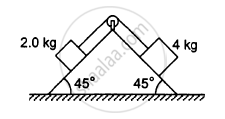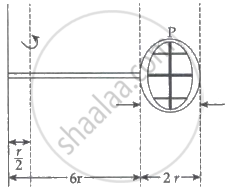Advertisements
Advertisements
प्रश्न
Two discs of moments of inertia I1 and I2 about their respective axes (normal to the disc and passing through the centre), and rotating with angular speeds ω1 and ω2 are brought into contact face to face with their axes of rotation coincident. (a) What is the angular speed of the two-disc system? (b) Show that the kinetic energy of the combined system is less than the sum of the initial kinetic energies of the two discs. How do you account for this loss in energy? Take ω1 ≠ ω2.
उत्तर
a)Moment of inertia of disc `I = I_1`
Angular speed of disc `I = omega_1`
Angular speed of disc II = `I_2`
Angular momentum of disc II = `omega_1`
Angular momentum of disc I = `L_1 = I_1omega_1`
Angular momentum of disc II, `L_2 = I_2omega2`
Total initial angular momentum, `L_1 = I_1omega_1 + I_2omega_2`
When the two discs are joined together, their moments of inertia get added up.
Moment of inertia of the system of two discs, I = `I_1 + I_2`
Let ω be the angular speed of the system
Total final angular momentum, `L_f = (I_1 + I_2) omega`
Using the law of conservation of angular momentum, we have:
`L_i = L_f`
`I_1omega_1 + I_2omega_2 = (I_1+_ I_2)omega`
`:. omega = (I_1omega_1 + I_2omega_2)/(I_1+I_2)`
b) Kinetic energy of disc I, `E_1 = 1/2 I_1omega_1^2`
Kinetic energy of disc II, `E_2 = 1/2 I_2omega_2^2`
Total initial kinetic energy, `E_i = 1/2 (I_1omegha_1^2 + I_2omega_2^2)`
When the discs are joined, their moments of inertia get added up.
Moment of inertia of the system, `I=I_1+I_2`
Angular speed of the system = ω
Final kinetic energy Ef:
`=1/2(I_1 +I_2)omega^2`
`=1/2 (I_1+I_2)((I_1omega_1 + I_2omega_2)/(I_1+I_2))^2 = 1/2 (I_1omega_1 + I_2omega_2)/(I_1+I_2)`
`:.E_i - E_f`
`=1/2 (I_1omega_1^2 + I_2omega_2^2) - (I_1omega_1 + I_1omega_2)^2/(2(I_1+I_2))`
`=1/2 I_1omega_1^2 + 1/2 I_2omega_2^2 - 1/2 (I_1^2omega_1^2)/(I_1+I_2) - 1/2 (I_2^2omega_2^2)/(2(I_1+I_2)) - 1/2 (2I_1I_2omega_1omega_2)/(2(I_1+I_2))`
`=1/(I_1+I_2) [1/2 I_1^2omega_1^2 + 1/2 I_1I_2omega_1^2 + 1/2 I_1I_2omega_2^2 + 1/2 I_2^2omega^2 - 1/2I_1^2 omega_1^2 - 1/2 I_2^2omega_2^2 - I_1I_2omega_1omega_2]`
`= (I_1I_2)/(2(I_1+I_2))[omega_1^2 + omega_2^2 - 2omega_1omega_2]`
= `(I_1I_2(omega_1-omega_2)^2)/(2(I_1+I_2))`
All the quantities on RHS are positive
`:.E_i - E_f > 0`
`E_i > E_f`
The loss of KE can be attributed to the frictional force that comes into play when the two discs come in contact with each other.
APPEARS IN
संबंधित प्रश्न
A hoop of radius 2 m weighs 100 kg. It rolls along a horizontal floor so that its centre of mass has a speed of 20 cm/s. How much work has to be done to stop it?
A solid cylinder rolls up an inclined plane of angle of inclination 30°. At the bottom of the inclined plane, the centre of mass of the cylinder has a speed of 5 m/s.
(a) How far will the cylinder go up the plane?
(b) How long will it take to return to the bottom?
Let IA and IB be moments of inertia of a body about two axes A and B respectively. The axis A passes through the centre of mass of the body but B does not.
The descending pulley shown in the following figure has a radius 20 cm and moment of inertia 0⋅20 kg-m2. The fixed pulley is light and the horizontal plane frictionless. Find the acceleration of the block if its mass is 1⋅0 kg.

The pulley shown in the following figure has a radius 10 cm and moment of inertia 0⋅5 kg-m2about its axis. Assuming the inclined planes to be frictionless, calculate the acceleration of the 4⋅0 kg block.

Solve the previous problem if the friction coefficient between the 2⋅0 kg block and the plane below it is 0⋅5 and the plane below the 4⋅0 kg block is frictionless.
Four bodies of masses 2 kg, 3 kg, 4 kg and 5 kg are placed at points A, B, C, and D respectively of a square ABCD of side 1 metre. The radius of gyration of the system about an axis passing through A and perpendicular to plane is
From a circular ring of mass ‘M’ and radius ‘R’ an arc corresponding to a 90° sector is removed. The moment of inertia of the remaining part of the ring about an axis passing through the centre of the ring and perpendicular to the plane of the ring is ‘K’ times ‘MR2 ’. Then the value of ‘K’ is ______.
Moment of inertia (M.I.) of four bodies, having same mass and radius, are reported as :
I1 = M.I. of thin circular ring about its diameter,
I2 = M.I. of circular disc about an axis perpendicular to disc and going through the centre,
I3 = M.I. of solid cylinder about its axis and
I4 = M.I. of solid sphere about its diameter.
Then -
Consider a badminton racket with length scales as shown in the figure.

If the mass of the linear and circular portions of the badminton racket is the same (M) and the mass of the threads is negligible, the moment of inertia of the racket about an axis perpendicular to the handle and in the plane of the ring at, `r/2` distance from the ends A of the handle will be ______ Mr2.
